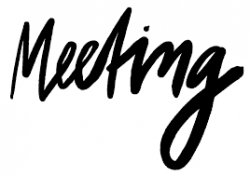 Designate a Facilitator
Designate a Facilitator
The facilitator is usually the “driver” of the meeting. She helps the group understand and achieve their objective(s), assists the group in following the agenda and staying on schedule. The facilitator should ensure that notes are taken. Often, but not always, the facilitator is the person who initiates and schedules the meetings.
Have a Clear, Obtainable Objective
Before the meeting , an objective (or set of objectives) for the meeting should be drafted and communicated to the entire group. The objective should follow SMART criteria: specific, measurable, attainable, relevant and time-bound.
If you are meeting to make a series of decisions, state what specific decisions need to be made.
Create and Distribute an Agenda
Having an agenda is essential for keeping a meeting focused and timely. Whenever possible, circulate the agenda ahead of time so attendees can:
a) determine the important of their presence at the meeting and prioritize their schedule accordingly, and
b) prepare for the meeting.
In agendas I draft, I always include the following:
- Meeting Title & Date
- Objective
- Attendees
- Agenda / Notes
- Action Items
Make Sure You Really Need a Meeting
It sounds simple, but before you schedule a meeting, ask yourself if you really need one. Can you clearly state your objective and draft an agenda?
Include Compete Participation Instructions
Include complete participation instructions every time, even for regular meetings with regular participants. The reason for this is that you want as few barriers to attending your meeting and being on time for it as possible.
Things to consider including in your meeting invite:
Date and time and physical location (if there is one) and any special access instructions
Be Mindful of Participants’ Time
Because people’s time is precious, we should be mindful when requesting and utilizing it.
There are several aspects to being mindful of your participants’ time:
- Make sure each participant is really required at the meeting.
- Each of your participants should have an integral role in obtaining the objective of your meeting.
- If they don’t, add them as an optional attendee or don’t invite them at all.
- Start on-time and end on-time.
Take Notes
One of the most important things you can do during a meeting is to ensure that good notes are taken.
Taking notes has the following benefits:
- Helps to keep participants focused and on-track during the meeting.
- Provides a clear record of what was discussed and decided during the meeting, for reference both by those who attended the meeting and those who were not able to do so.
- You don’t need to create perfect notes while the meeting is happening. Just record the important information and be prepared to edit afterward.
Follow-Up
A good meeting is not complete until you’ve distributed and recorded the revised meeting notes (or minutes), with key decisions and action items clearly indicated.
The complete agenda and note-taking process looks like this:
- Create and circulate an agenda in advance of the meeting.
- Take notes, with the group’s assistance, in the same document you used for the agenda.
- Edit the notes after the meeting is complete, making sure to call out key decisions and action items.
- Distribute the edited notes to everyone you invited to the meeting .
Categorised in: General, Growing
This post was written by
Please Subscribe and get Notified when new articles are posted

